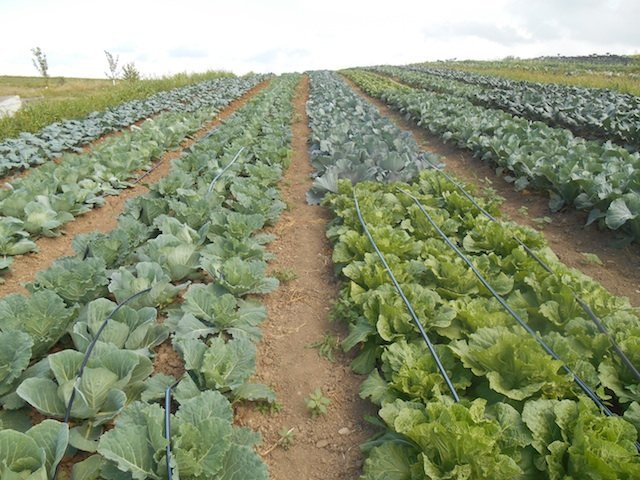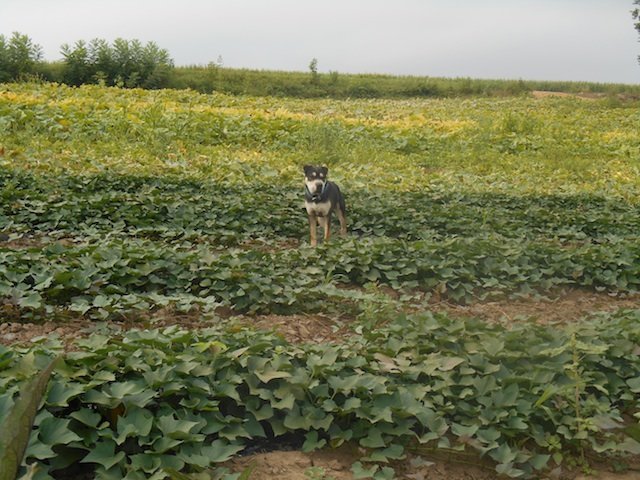
Do you ever open up your CSA box and wonder why some of the vegetables inside don’t look quite like what you’re used to seeing at the grocery store? Do you look at your peppers or your tomatoes and wonder why they’re shaped so funny or look so much different than what you’re used to seeing from grocery store standards? If you have any experience gardening at all, you know that not every vegetable that comes from your garden looks like the ones from the grocery store. If you don’t have any experience gardening, you’re probably wondering if we know what we’re doing out here on the Small Family Farm.  Some of our Fall Cabbages with drip line running over the top of the rows. It has been very, very dry on the farm the last few weeks!
Some of our Fall Cabbages with drip line running over the top of the rows. It has been very, very dry on the farm the last few weeks!
There is a lot to be said on this subject. Because we are able to include #1 and #2 quality produce in our boxes, we are able to give you more food in each box. While our first preference is to pack our CSA boxes with all large, #1 quality of produce, conditions on the farm don’t always cooperate. Because we are a CSA farm and we grow over 100 different varieties of vegetables, it is nearly impossible to grow first quality of everything we grow. It might be much easier for a farmer to have only one or two crops to focus on where all of the planting, cultivating, disease and pest management and harvesting all happen in the same visits to the field. But because all in one day we will harvest several different kinds of crops, weed a few more, and then maybe plant a few more, we have a lot going on in one day.
Our workers love the change in routine. Because we rarely ever do the same thing on the farm for more than 3 hours at a time, we will frequently spend one or two hours on one task, and then move onto another. This makes for a fast-paced day. Don’t get me wrong, there is plenty of repetition and monotony on the farm; but both a changing crew size and varying crop sizes are factors that determine how long we spend on one crop. A well-diversified, small farm like ours with staggering successions of vegetables coming in and out of season can be a beautiful display to watch unfold.
But that doesn’t explain why your peppers are sometimes half-green and half red or why your kale this week has some bites around the edges of the leaves or why sometimes the beets aren’t perfectly round or the carrots sometimes spiral or fork. The truth is multi-tiered. I made a short list of some of the reasons why we justify sending a mixture of first and second quality produce at times.
-We might not be able to afford to grow 50% more of each crop that we grow, so that we can toss all of the “seconds”.
-We think that they all taste the same, no matter what shape they are.
-We’re reducing food waste by not throwing everything that isn’t perfect looking away.
-We’re able to give you more food at a reduced price because we can include some second-quality items like funky heirlooms at times.
-It’s enlightening for us all to see what real food looks like that hasn’t been through an extremely harsh culling procedure.
– We can grow new and unusual varieties of vegetables in our CSA program that you would never be able to find at a supermarket.
While this newsletter is not meant to warrant for shipping low-quality produce to CSA members, it is to ask for a small amount of forgiveness on the part of the person who is new to eating local food. As farmers we still take a lot of pride in growing very high-quality, nutrient-dense and very fresh produce and we do everything we can to keep the bar high. It’s a little too easy to grow low-grade vegetables and it is the mark of a good farmer who can take the time and care and effort to do everything in their power to grow their crops well. At times we go to great lengths to keep our crops watered, sprayed or fertilized, so we know how much work and effort goes into keeping crops healthy. I only wish to raise awareness for the bottle-necked cucumber. We hope you’re enjoying the flavorful ride through this pleasant 2014 growing season!
Canary Melons- These are a bright yellow melon that looks a little like a spaghetti squash. We have had members mistake these melons for spaghetti squash in the past, so take note that this is indeed a sweet melon! These have a green, hard, crunchy flesh like that of a kohlrabi, so don’t wait for these melons to turn soft! Their flavor is very sweet and delicious, I’m sure you’ll love it! These are a new favorite of ours! Our lovable yet fierce farm dog, Mugzie. Thanks for protecting the sweet corn for us, Mugzie from the racoons!
Our lovable yet fierce farm dog, Mugzie. Thanks for protecting the sweet corn for us, Mugzie from the racoons!
Red Cabbage- A terrific year for red cabbage on our farm! Usually they are a little more challenging to grow. We tried a new variety this year we’re really happy with. We’ll take a couple week break from cabbage now and switch to carrots and potatoes the next two weeks!
Eggplant- Either a long and skinney Japanese Dairyu eggplant, a standard Santana Eggplant, or a majenta colored Dancer eggplant. We try to grow a unique mixture of fun sized and colored eggplants. Eggplants are a tropical fruit that stores best at 50% and they will wilt in the refrigerator, their flavor and texture will be best if used within a few days.
Sweet Corn- Unfortunately, this is the final giving of sweet corn for the season. Our loyal dog, Mugzie deserves recognition for defending our sweet corn patch this summer. Farmer Adam tied him up out by the sweet corn ever night for the last three weeks. Mugzie is officially off-duty and sleeping in the house again at night, lucky dog!
White Onion- We distribute our white onions first because they are not a storage variety and they won’t store into the winter. We’ve got red, yellow and cippolini to share later this season as well!
Summer Squash, Zucchini or Patty Pans- One or two squash per member this week. This is likely the final giving of our soft, summer squashes. I would say that we had a fantastic run while they lasted and we have more amazing veggie variety ahead of us!
Cucumbers- One or two cukes per member this week. Also the final week of cucumbers. It’s a little sad, but we had a good go at the cucumbers while they lasted!
Red Beets- Two or three red beets per box this week. There were also some golden beets in the mixture. If you received a large yellow root in your box that looks a little like a beet, it IS a beet. Consider this to be like getting the golden wrapper on your chocolate bar. Golden beets are a little difficult to grow and we only have a small patch of them this year. As they come to size we will distribute them. They’re nice because they won’t turn your dish red.
Sweet Bell Peppers- We’re very excited that our bell peppers are coming into season now. We are harvesting red, yellow and orange bells. We typically do not harvest our peppers green. There were a few green ones that made it into boxes this week that were harvested on accident or fell off the plant while reaching for a red one. Our peppers aren’t always as perfectly shaped as what you’re used to seeing at the grocery store. They might grow a little rumpled or squeezed or irregular shaped. If they looked like a good eating pepper to us, we included them in the boxes!
Green Beans or Broccoli- Our first succession of green beans is done now, and these were the last of the beans we picked off of those plants. We’re expecting another big flush of beans for the next couple of weeks in the boxes. The last of our summer broccoli made it into the boxes this week if you didn’t get green beans.
Jalapeno Hot Pepper- These are the small, green spicy ones!
Hungarian Hot Wax Pepper- These are the lime-green, longer, banana pepper ones. These aren’t so spicy at all! Sometimes these Hungarian hot wax peppers turn an orange-ish color when fully ‘ripe’. If you get one like this, consider yourself lucky as their flavor typically sweetens.
Curly Parsley- These were very small bunches of curly parsley this week. Our plants have some kind of rust or disease on them that is causing us to have to discard most of the plant leaves.
Lacinato Kale- Also very small bunches of Lacinato kale this week. There was a good amount of flea-beetle damage on the leaves, so we ‘cleaned’ the plants up and gave small bunches. We’re hoping that the plants will regenerate and we’ll have gorgeous acinato for the fall boxes.
Mixed Tomatoes- A mixed variety of tomatoes. We aware that some tomatoes are fully red, yellow, purple, or even pink when fully ripe. Not all tomatoes are red! You’ll notice some funky heirloom behavior with some cracking in the creases on the heirloom tomatoes. What they lack in perfect appearance, they make up for in flavor.
Note about tomatoes and ripening: If your tomatoes are fully ripe, it is okay to put them in the refrigerator to buy yourself a little time to eat them up. You may compromise the flavor a little putting your tomatoes in the refrigerator, but at least they won’t go bad on you as quickly. If your tomatoes are not fully ripe, it is important that you allow them to ripen at room temperature; they will not ripen in the refrigerator.
Greek Yogurt Cucumber Sauce (great dipping sauce for the above recipe)